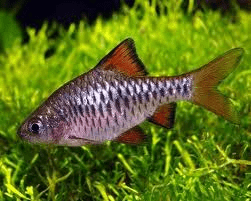
Common name: Checkered Barb
Scientific name: Puntius Oligolepis
Average Adult Fish Size: 2 inches / 5 cm
Place of Origin: Indonesia
Typical Tank setup: A well planted aquarium with rock work and driftwood / bogwood. Plants will give the weaker individuals a place to hide, until the pecking order of the school is established. Checkered Barbs are one of the fish species that will benefit greatly from a dark substrate, as it will cause them to exhibit a more brilliant coloration.
Recommended Minimum Aquarium Capacity: 30 gallon / 120 litre
Compatibility: The Checkered Barb needs to be kept in schools. The larger the school the better with 9 fish a good minimum amount. If kept in smaller schools the weaker individuals will be harassed continuously by the more aggressive individuals until they die. Checkered Barbs have a tendency to nip the fins of slow fish and ones that have long flowing fins. The way to combat this is to keep them in a large enough school. If this is done, they will generally keep themselves busy within the school and usually not bother their tankmates too much. If kept with smaller fish, they too should be kept in a school.
Temperature: 68 – 79 Deg F / 20 – 26 Deg C
Water chemistry: pH 6.0 – 7.5
Feeding: Omnivorous. They should be fed a varied diet of flakes, small pellets, frozen and live foods such as daphnia and brine shrimp. Blood worms and brown worms can also be fed as a treat, but do not feed worms very often as they can cause bloat.
Sexing: The Checkered barb is very easy to sex. The males are more colorful and have black edges on their dorsal and anal fins. The females are less colorful, often rounder, and have yellowish fins without the distinct black edges seen in males.
Breeding: The Checkered barb is rather easy to breed and is best bred in pairs. Group spawnings often fail since the males fight rather than make love. It is important to keep this fish at colder temperature during a simulated winter if you want them to breed. They might breed without this colder season it is not very common.
Fill a suitable sized breeding aquarium with somewhat acidic water (pH 6.0). The temperature in the aquarium should be kept near 26°C (79°F). A low water level, ideally 10-15 cm (4-6 inches), helps trigger spawning. The bottom of the tank should be covered with a mesh that protects the eggs from the parents as these will eat their own egg and fry. The aquarium should also contain fine leafed plants or spawning mops.
Separate male and female barbs to condition them for spawning. After about 3 weeks of being separate the fish should be ready to spawn if they have been given a good and varied diet with a lot of frozen and live food. Choose the most colorful Checkered barb male and the fattest female for the spawning and move them to the breeding tank. The pair usually spawns the next morning in a plant chosen by the male. Sunlight that hits the aquarium can help trigger spawning. Remove the parents once spawning is completed.
A spawning can result in up to 300 eggs. The fry hatch in 24-48 hours. Feed the fry as soon as they are free swimming and switch to newly hatch brine shrimp when they have become large enough to eat them. The fry grow very fast and can reach adulthood in 4-6 months.
Additional Information: The Checkered Barb is a small friendly fish that is perfect for any community aquarium with other small species that will not be disturbed by the lively demeanor of this fish. Male checkered barbs can often fight and it is therefore best to keep only one male with several females if you are keeping them in a smaller aquarium. In a larger aquarium you can keep several males and females, provided that the aquarium is properly decorated.

Related Posts
Croaking Gourami – Trichopsis vittatus
Paradise Fish – Macropodus opercularis
Schubert’s Barb – Barbus Semifasciolatus